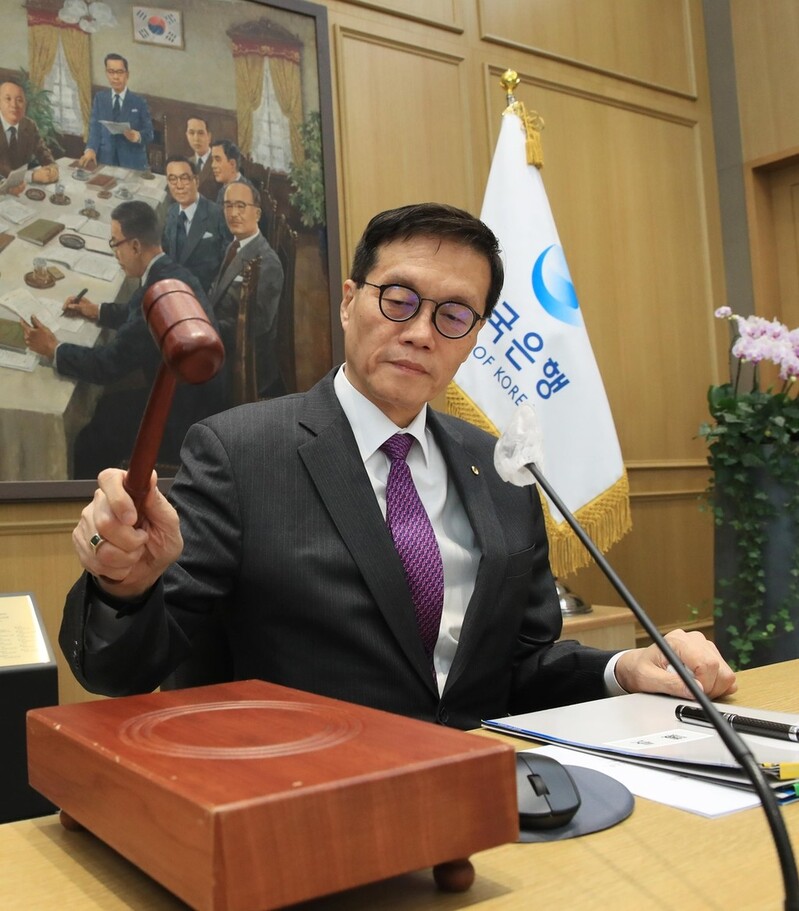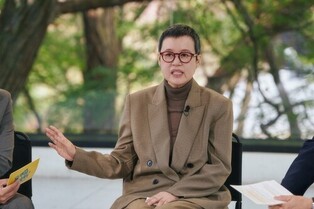 |
| ▲ Bank of Korea Gov. Rhee Chang-yong bangs the gavel during a rate-setting meeting at the bank's headquarters in Seoul on Nov. 30, 2023 (Pool photo) (Yonhap) |
(LEAD) BOK-rate freeze
(LEAD) BOK freezes key rate for 7th time, cuts 2024 growth outlook
(ATTN: RECASTS headline, lead, throughout; CHANGES photo)
SEOUL, Nov. 30 (Yonhap) -- South Korea's central bank held its key interest rate steady for the seventh straight time Thursday as it cut its growth outlook for next year amid uncertainties.
In a widely expected decision, the monetary policy board of the Bank of Korea (BOK) kept the benchmark seven-day repo rate unchanged at 3.5 percent.
This marked the seventh straight time that the BOK has stood pat following rate freezes in February, April, May, July, August and October. The rate freezes came after the BOK delivered seven consecutive rate hikes from April 2022 to January 2023.
The central bank maintained its growth estimate for the year at 1.4 percent but slashed next year's to 2.1 percent from 2.2 percent. It also jacked up the inflation forecast for next year to 2.6 percent from its earlier estimate of 2.4 percent.
South Korea's economy has been dogged by slumping exports and sluggish consumer spending. For the year, the central bank has expected Asia's fourth-largest economy to expand 1.4 percent, but it is still unclear whether such a forecast will be achieved in the face of a still murky economic outlook.
Weak global demand, led by China's slowing economy, and a delay in the recovery of the IT sector have been blamed for a slump in the country's outbound shipments, one of the country's growth drivers.
But recently, the country's exports have shown signs of recovering.
The country's exports rebounded for the first time in 13 months in October, driven by robust auto shipments, along with signs of an improvement in the chip sector.
Outbound shipments moved up 5.1 percent on-year to US$55 billion last month and logged a trade surplus of $1.64 billion in October, the fifth straight gain.
The economy grew 0.3 percent, 0.3 percent and 0.6 percent, respectively, in the first, second and third quarters.
Last year, the country's economy grew 2.6 percent, slowing from a 4.1 percent advance in 2021 and marking the slowest pace since 2020, when the economy contracted 0.7 percent amid the fallout from the coronavirus pandemic.
Policymakers have also pinned hopes on easing inflation, helping the central bank take a breather in its rate hike moves.
South Korea's inflation grew at a faster pace of 3.8 percent in October, staying above 3 percent for the third consecutive month, due to higher prices of energy and farm goods.
It is the third month in a row that the annual price growth has picked up pace.
But oil prices have been stabilizing in the face of the Israel-Hamas war, possibly helping inflation ease down the road, a development that supports the central bank's rate freeze.
The central bank is also paying keen attention to rising household debts, which could help domestic demand weaken.
Household loans extended by banks in South Korea rose for the seventh straight month in October, led by rising home-backed loans amid high borrowing costs.
Banks' outstanding household loans reached a record high of 1,086.6 trillion won (US$833.6 billion) at end-October, up 6.8 trillion won from a month earlier, accelerating from a 4.8 trillion-won rise the previous month and marking an on-month increase for the seventh month in a row.
The BOK's rate freeze also came in the face of the rate difference with the United States widening.
Higher rates in the U.S. are feared to prompt money outflows from South Korea, thereby weakening the local currency against the dollar and exerting upward inflation pressure by making imports more expensive.
Early this month, the Fed held its benchmark lending rate steady at a 22-year high for the second consecutive time as it keeps striving to bring down inflation to its 2 percent target.
The Fed kept the rate between 5.25 and 5.50 percent, but it left open the possibility of a rate change later to achieve "maximum" employment and its inflation target.
The Fed started its aggressive campaign of rate hikes in March last year to tame inflation.
Next month, the Fed is widely expected to stand pat again.
(END)
(C) Yonhap News Agency. All Rights Reserved























![[가요소식] 조항조, 새 싱글](/news/data/20251116/yna1065624915927473_582_h2.jpg)










